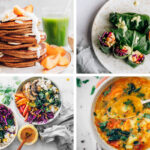Tired of boring salads? Prepare to rediscover the vibrant world of vegetarian cuisine with recipes that are as delicious as they are nutritious. This guide dives deep into the art of crafting healthy, flavorful vegetarian salads, exploring a spectrum of ingredients, exciting flavor combinations, and stunning presentation techniques. From understanding the nutritional powerhouses within common salad components to mastering the perfect vinaigrette, we’ll empower you to create salads that are not just healthy, but genuinely enjoyable, meals you’ll crave again and again.
We’ll journey through a curated selection of popular ingredients, uncover the secrets to creating balanced flavor profiles, and guide you step-by-step through the creation of a delectable quinoa salad with roasted vegetables. Along the way, we’ll explore adaptable variations, serving suggestions, and answer common questions to ensure your salad-making journey is both effortless and rewarding. Get ready to elevate your vegetarian eating experience!
Popular Vegetarian Salad Ingredients
Vegetarian salads offer a vibrant and nutritious way to enjoy a delicious and healthy meal. The key to a truly satisfying vegetarian salad lies in the careful selection of ingredients that provide a balance of textures, flavors, and nutritional benefits. This section explores some of the most popular ingredients and their contributions to a well-rounded salad.
Ten Popular Vegetarian Salad Ingredients and Their Nutritional Benefits
Choosing the right ingredients is crucial for creating a healthy and flavorful vegetarian salad. The following list highlights ten popular options and their nutritional advantages.
- Leafy Greens (Spinach, Kale, Romaine): Rich in vitamins A, C, and K, as well as iron and antioxidants. Spinach offers a mild, slightly sweet flavor, while kale provides a more robust, slightly bitter taste, and romaine lettuce offers a crisp and refreshing crunch.
- Tomatoes: A good source of lycopene, a powerful antioxidant linked to reduced cancer risk, and vitamin C. Their juicy texture and slightly acidic taste add brightness to any salad.
- Cucumbers: Hydrating and low in calories, cucumbers contribute a refreshing crunch and mild flavor. They are also a good source of vitamin K.
- Bell Peppers (Red, Yellow, Orange): Packed with vitamins A and C, bell peppers add vibrant color and a sweet, slightly crisp texture. Different colors offer varying levels of sweetness and nutrients.
- Carrots: An excellent source of beta-carotene, which the body converts to vitamin A, carrots provide a sweet crunch and a vibrant orange hue.
- Onions (Red, White, Yellow): Adding a pungent bite and a range of flavors from sweet to sharp, onions contribute significant amounts of antioxidants and beneficial compounds.
- Avocado: Creamy and rich in healthy fats, fiber, and potassium, avocado adds a luxurious texture and a subtly nutty flavor.
- Mushrooms: Earthy and umami-rich, mushrooms provide a meaty texture and are a good source of selenium and B vitamins. Different varieties offer unique flavor profiles.
- Legumes (Chickpeas, Black Beans, Lentils): Excellent sources of protein and fiber, legumes add heartiness and a satisfying texture to salads. Their flavors range from subtly sweet to earthy and robust.
- Nuts and Seeds (Almonds, Walnuts, Sunflower Seeds): Adding healthy fats, protein, and fiber, nuts and seeds provide a satisfying crunch and a boost of flavor and nutrients. They are also rich in vitamin E and antioxidants.
Texture and Flavor Comparison of Leafy Greens
The choice of leafy green significantly impacts the overall texture and flavor profile of a vegetarian salad. The following table compares some popular options.
| Leafy Green | Texture | Flavor | Nutritional Highlights |
|---|---|---|---|
| Spinach | Tender, delicate | Mild, slightly sweet | High in vitamins A & K, iron |
| Kale | Slightly tough, chewy | Robust, slightly bitter | High in vitamins A, C & K |
| Romaine Lettuce | Crisp, crunchy | Mild, refreshing | Good source of vitamin K & folate |
| Butter Lettuce | Very tender, delicate | Mild, buttery | Good source of vitamin A & folate |
Versatility of Beans and Legumes in Vegetarian Salads
Beans and legumes are incredibly versatile additions to vegetarian salads, offering a substantial source of protein and fiber, alongside a diverse range of flavors and textures. Chickpeas, for example, provide a firm, slightly earthy taste and work well in Mediterranean-style salads. Black beans, with their slightly sweet and subtly smoky flavor, are ideal for Southwestern-inspired salads. Lentils, available in various colors (red, green, brown), offer a range of textures from tender to firm and flavors from nutty to slightly earthy, adding depth and heartiness to salads. Their versatility allows them to complement a wide variety of dressings and other ingredients. The addition of beans and legumes transforms a simple salad into a complete and satisfying meal.
Flavor Combinations and Dressings

The magic of a truly exceptional vegetarian salad lies not just in the vibrant array of ingredients, but in the harmonious interplay of flavors and the perfect complement of a well-crafted dressing. The right dressing can elevate a simple salad to a culinary masterpiece, transforming textures and enhancing the natural sweetness or earthiness of the vegetables. Exploring diverse flavor profiles and dressing options is key to unlocking the full potential of vegetarian salads.
Five Unique Vegetarian Salad Dressings
Creating your own dressings allows for complete control over ingredients and flavor intensity. Here are five unique and flavorful options to inspire your culinary creativity:
- Lemon-Tahini Dressing: A vibrant and creamy dressing that balances the tang of lemon with the nutty richness of tahini. Whisk together 1/4 cup tahini, 2 tablespoons lemon juice, 1 tablespoon water, 1 clove garlic (minced), a pinch of salt, and a dash of black pepper. Adjust water for desired consistency. The creamy texture contrasts beautifully with crunchy vegetables like cucumbers and bell peppers. Imagine the bright yellow lemon juice swirling through the pale tahini, creating a visually appealing dressing.
- Balsamic Vinaigrette with Roasted Red Peppers: The deep, tangy notes of balsamic vinegar are beautifully enhanced by the sweetness of roasted red peppers. Blend 1/4 cup balsamic vinegar, 2 tablespoons olive oil, 1 roasted red pepper (pureed), 1 teaspoon Dijon mustard, and a pinch of salt and pepper. The roasted peppers add a smoky depth that complements earthy greens like spinach or kale. Picture the rich, dark red of the roasted pepper contrasting with the deep brown of the balsamic.
- Maple-Dijon Mustard Dressing: A surprisingly delightful combination of sweet and savory. Whisk together 2 tablespoons maple syrup, 2 tablespoons Dijon mustard, 1 tablespoon apple cider vinegar, 2 tablespoons olive oil, and a pinch of salt and pepper. This dressing works wonderfully with salads featuring roasted sweet potatoes or butternut squash, creating a balance of sweetness and tang. The golden hue of the maple syrup blends beautifully with the mustard’s yellowish-brown.
- Avocado Cilantro Lime Dressing: A vibrant and refreshing dressing perfect for lighter salads. Blend 1 ripe avocado, 1/4 cup cilantro, 2 tablespoons lime juice, 1 tablespoon water, 1/4 teaspoon cumin, and a pinch of salt. The creamy avocado provides a smooth texture that pairs well with corn, black beans, and bell peppers. Imagine the vibrant green of the avocado and cilantro mingling in a creamy, vibrant dressing.
- Spicy Peanut Dressing: A bold and flavorful dressing with a kick. Whisk together 1/4 cup peanut butter, 2 tablespoons soy sauce, 2 tablespoons rice vinegar, 1 tablespoon sesame oil, 1 tablespoon sriracha (or more, to taste), and 1 tablespoon water. This dressing is ideal for salads with Asian-inspired ingredients like edamame, shredded carrots, and chopped peanuts. The rich reddish-brown of the peanut butter and sriracha creates a visually appealing contrast.
Contrasting Flavor Profiles in Vegetarian Salads
The successful construction of a vegetarian salad often involves balancing contrasting flavors to create a more dynamic and enjoyable eating experience.
- Sweet & Savory: A salad featuring roasted sweet potatoes, crumbled feta cheese, toasted pecans, and a maple-Dijon vinaigrette showcases the delightful contrast between the natural sweetness of the sweet potatoes and the savory tang of the cheese and dressing. The warm, earthy sweetness of the roasted sweet potatoes is balanced by the salty, sharp feta and the tangy mustard. The visual contrast between the deep orange of the sweet potatoes, the creamy white of the feta, and the rich brown of the pecans is equally striking.
- Spicy & Creamy: A salad with black beans, corn, avocado, red onion, jalapeno peppers, and a creamy cilantro-lime dressing provides a delicious interplay of spicy heat and cool creaminess. The heat from the jalapenos is tempered by the cool, rich creaminess of the avocado, creating a satisfying balance. The visual contrast between the vibrant greens, yellows, and reds of the vegetables and the creamy green of the avocado dressing is very appealing.
- Tangy & Earthy: A salad with wilted spinach, roasted beets, crumbled goat cheese, and a balsamic vinaigrette offers a beautiful blend of tangy and earthy flavors. The earthy sweetness of the beets is complemented by the tangy balsamic vinegar and the creamy goat cheese. The vibrant colors of the beets, the deep green of the spinach, and the creamy white of the goat cheese create a visually stunning salad.
Impact of Herbs and Spices on Vegetarian Salads
Herbs and spices are not mere additions; they are the architects of flavor and aroma in vegetarian salads. They can amplify existing tastes, introduce entirely new dimensions, and enhance the overall sensory experience.
A small amount of finely chopped fresh herbs like dill, parsley, or cilantro can brighten up a salad and add a fresh, herbaceous note. Similarly, spices such as cumin, coriander, or paprika can add warmth and depth, while a pinch of red pepper flakes can introduce a welcome level of heat.
The aromatic notes of herbs like basil, oregano, or thyme can transform a simple salad into a fragrant and memorable dish. Experimentation with different herb and spice combinations is encouraged – the possibilities are virtually limitless.
Presentation and Serving Suggestions
Elevating your vegetarian salad from a simple side dish to a culinary masterpiece involves thoughtful presentation. The visual appeal of a salad can significantly enhance the dining experience, making it as enjoyable to look at as it is to eat. Careful plating techniques and strategic garnishes can transform even the simplest salad into a vibrant and enticing dish. Proper storage is also crucial to maintain the freshness and quality of your creations.
Visually Appealing Salad Presentations
Three distinct approaches can create visually stunning vegetarian salads. The first focuses on height and layering, the second on color contrast and arrangement, and the third on the use of unique serving vessels.
Layered Salad with Height: Imagine a vibrant green base of mixed greens, followed by a layer of colorful roasted vegetables like bell peppers and zucchini, artfully arranged to create height and visual interest. Next, add a layer of creamy avocado slices, followed by a sprinkle of toasted nuts and seeds for texture and visual contrast. A final flourish of a vibrant herb like basil or cilantro adds a pop of color and freshness. The height of the salad creates a sense of abundance and draws the eye.
Color-Blocked Salad: This technique utilizes the natural colors of ingredients to create a visually striking presentation. Imagine sections of vibrant red cherry tomatoes nestled beside bright orange carrots and deep green spinach. The contrasting colors create a visually appealing pattern, making the salad feel more like a work of art than just a simple meal. A simple vinaigrette dressing, drizzled artfully, adds a final touch of elegance. The arrangement makes the salad both aesthetically pleasing and easily digestible, allowing for the individual appreciation of each component.
Salad in a Unique Vessel: Instead of a standard bowl, consider serving your salad in a hollowed-out avocado, a crisp lettuce cup, or even a small, decorative mason jar. This adds an element of surprise and sophistication. For example, a vibrant quinoa salad with colorful vegetables could be beautifully presented in a hollowed-out red bell pepper, creating a striking visual contrast and a delicious edible bowl. The unexpected vessel elevates the presentation and provides an element of fun and novelty.
Storing Leftover Vegetarian Salads
Proper storage is essential to maintain the freshness and quality of leftover vegetarian salads. To prevent wilting and sogginess, separate dressing from the salad components. Store the dressing in a separate airtight container. Toss the salad with the dressing just before serving. Store the salad in an airtight container in the refrigerator. For best results, consume within 2 days. Consider using a shallow container to ensure even cooling and minimize moisture buildup. This will help preserve the crispness and vibrant colors of your ingredients.
Creating a Balanced and Nutritious Meal with a Vegetarian Salad
Vegetarian salads can be the foundation of a complete and balanced meal. To ensure nutritional adequacy, incorporate a variety of textures and nutrients. Pair a hearty salad with a source of protein, such as grilled tofu, chickpeas, or lentils. Include healthy fats like avocado or nuts to promote satiety and nutrient absorption. A whole-grain bread or a small portion of brown rice can add complex carbohydrates for sustained energy. For example, a large salad with grilled halloumi cheese, quinoa, roasted vegetables, and a lemon-herb vinaigrette provides a complete and satisfying meal. The combination of protein, healthy fats, and complex carbohydrates ensures a balanced and nutritious meal.
Transforming simple ingredients into vibrant, flavorful masterpieces is the heart of creating truly enjoyable vegetarian salads. This guide has armed you with the knowledge and recipes to embark on a culinary adventure, exploring diverse ingredients, mastering flavor combinations, and perfecting presentation. Remember, a delicious vegetarian salad is more than just a side dish; it’s a celebration of fresh, healthy ingredients, and a testament to the boundless creativity within vegetarian cooking. So, embrace the possibilities, experiment with different flavors, and enjoy the satisfying crunch and vibrant tastes of your homemade creations!
Detailed FAQs
Can I make vegetarian salads ahead of time?
Yes, many vegetarian salads hold up well when made ahead. However, avoid adding dressings until just before serving to prevent the greens from wilting. Store in an airtight container in the refrigerator.
How can I make my vegetarian salads more filling?
Add protein-rich ingredients like beans, lentils, tofu, chickpeas, or nuts and seeds to increase satiety. Quinoa or farro also add heartiness and fiber.
What are some good substitutes for common salad ingredients?
Feel free to swap ingredients based on preference and availability. For example, substitute spinach for romaine, sunflower seeds for pumpkin seeds, or different types of beans for variety.
How do I prevent my salad dressing from separating?
Use a high-quality emulsifier like Dijon mustard or a little bit of honey to help bind the ingredients together and prevent separation.


